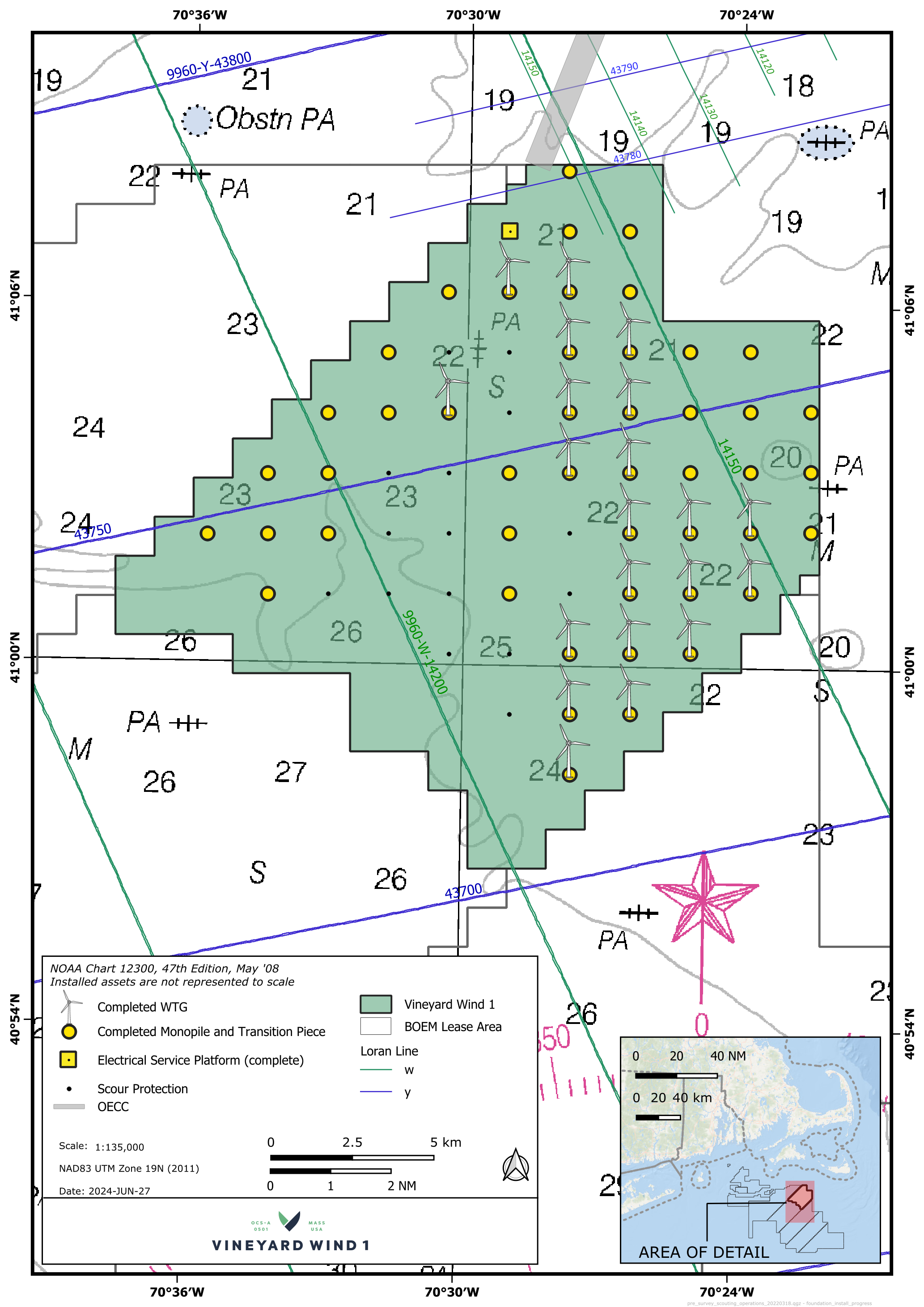Our Commitment to Nantucket
Vineyard Wind is committed to responsible offshore wind development, environmental protection, and working in partnership with local communities as we develop, construct, and operate Vineyard Wind 1.
Contact Our Community Engagement Team
Dana Rebeiro, Massachusetts Liaison drebeiro@vineyardwind.com
508-252-3386
Jeannine Louro, Education Initiatives Manager jlouro@vineyardwind.com
WATCH
Vineyard Wind 1 and Nantucket
Vineyard Wind 1 is located in federal offshore wind lease area OCS-A 0501, which is 15 miles south of Nantucket. The project consists of an array of 62 wind turbines, spaced 1-nautical mile apart in an east-west and north-south orientation. The project is delivering power directly to Massachusetts through offshore export cables that travel north of the lease area through Muskeget Channel to a landfall site and grid interconnection point in Barnstable.
The permitting process for Vineyard Wind 1 project began in 2018 and was completed in 2021. A portion of Vineyard Wind 1’s offshore export cable corridor passes through Nantucket’s offshore waters and was subject to Nantucket Conservation Commission review during the permitting process. The Town and County of Nantucket, along with several island organizations, also served as consulting parties to the National Historic Preservation Act Section 106 review of Vineyard Wind 1.
Vineyard Wind, the Town and County of Nantucket, and leading Island nonprofits also partnered in 2020 to create The Nantucket Offshore Wind Community Fund as part of the Good Neighbor Agreement (see below).
VINEYARD WIND IN NANTUCKET:
Good Neighbor Agreement
On August 27, 2020, Vineyard Wind, the Town and County of Nantucket, the Maria Mitchell Association, and the Nantucket Preservation Trust entered into the Good Neighbor Agreement, which established The Nantucket Offshore Wind Community Fund. The Fund supports local initiatives to combat the effects of global climate change, enhance coastal resiliency, and protect, restore, and preserve Nantucket’s cultural and historic resources.
Vineyard Wind provided $4 million to seed the Fund, which is administered by the Community Foundation for Nantucket. The Community Foundation for Nantucket issued its first round of grants from the Fund in May 2024.
The Good Neighbor Agreement also includes measures that Vineyard Wind agreed to implement to reduce the potential visual impact of Vineyard Wind 1 to Nantucket, including painting the wind turbines a non-reflective off-white/light gray color to blend into the horizon and installing Aircraft Detection Lighting System, a lighting system that reduces nighttime lighting for the project. Vineyard Wind also agreed to move the first row of wind turbines farther away from Nantucket.
The Good Neighbor Agreement can be found here.
Construction Update
Vineyard Wind 1 entered the construction phase shortly after achieving financial close in 2021. Construction activities began in Barnstable where the onshore substation and onshore export cables are located. Learn more about Vineyard Wind 1’s onshore infrastructure in Barnstable here.
Offshore construction activities began in 2022 with offshore export cable installation. Wind turbine installation activities in the lease area began in 2023 and are ongoing. Vineyard Wind 1 achieved first power on January 2, 2024, when one turbine delivered approximately 5 MW of power to the electricity grid.
+ Who reviews and permits offshore wind projects?
Offshore wind projects are subject to extensive permit reviews through federal, state, regional, and local regulators. In Massachusetts, this includes the Massachusetts Environmental Policy (MEPA) Office, the Massachusetts Department of Environmental Protection, the Energy Facilities Siting Board, the Massachusetts Office of Coastal Zone Management, the Massachusetts Division of Marine Fisheries, and the Massachusetts Department of Fish and Wildlife, which includes the Natural Heritage and Endangered Species Program.
On the federal level, permit review occurs through the Bureau of Ocean Energy Management (BOEM). BOEM’s review is conducted with extensive comments and review from other federal agencies including the Environmental Protection Agency, Army Corps of Engineers, US Coast Guard, and the Federal Aviation Administration.
On the local level, the Nantucket Conservation Commission approved the portion of the project located within Nantucket waters.
Learn more about Vineyard Wind 1’s permitting process here.
+ What are the climate benefits of Vineyard Wind 1?
Once fully operational, Vineyard Wind 1 is expected to reliably produce the amount of energy used by over 400,000 Massachusetts homes. The power produced by the project will eliminate 1.68 million metric tons of carbon dioxide emissions annually – the equivalent of taking 325,000 cars off the road. The direct emissions generated during Vineyard Wind 1’s construction, operation, and decommissioning will be offset after less than five months of the project achieving commercial operation.
+ Will the wind turbines be visible from Nantucket?
Vineyard Wind 1’s wind turbines may be visible from certain portions of Nantucket throughout the year. However, due to the project’s distance from shore (approximately 15 miles), no land-based vantage point on Nantucket will view an entire wind turbine; some portion of each wind turbine will always fall below the visible horizon. The visibility of the project during daylight hours will be impacted by weather conditions, air quality, sea spray, and other atmospheric conditions that limit visibility and obscure shoreline views.
+ What steps have been taken to reduce the visual impact of Vineyard Wind 1?
Vineyard Wind worked constructively with Nantucket leadership to resolve visual impact concerns. Through the Good Neighbor Agreement, Vineyard Wind agreed to move the project’s first row of turbines farther away from Nantucket, to install a lighting system that will be activated only when planes are nearby that reduces nighttime lighting to fewer than four hours per year, and to paint the turbines an off-white color to reduce their visibility.
+ What is ADLS?
Vineyard Wind agreed to install an Aircraft Detection Lighting System (ADLS) on Vineyard Wind 1. ADLS is a radar-activated lighting system that activates only when planes are within a specified distance of wind turbines. ADLS reduces the nighttime lighting of offshore wind projects and the associated visual impacts. Based on the historical use of the airspace surrounding Vineyard Wind 1, the ADLS will be activated for less than four hours per year (less than 0.1% of the total annual nighttime hours). A simulation video showing ADLS on Vineyard Wind 1 can be viewed here. Note that due to the speed of the traveling aircraft and size of lease area OCS-A 0501, the resulting appearance of the lights is limited to a few minutes as they turn on and then off quickly as demonstrated in the simulation video.
+ When will the ADLS be operational?
Vineyard Wind is currently installing the ADLS on Vineyard Wind 1. The technology will be implemented on commissioned wind turbines on a rolling basis. As this effort progresses, Vineyard Wind will provide regular updates on the town of Nantucket.








